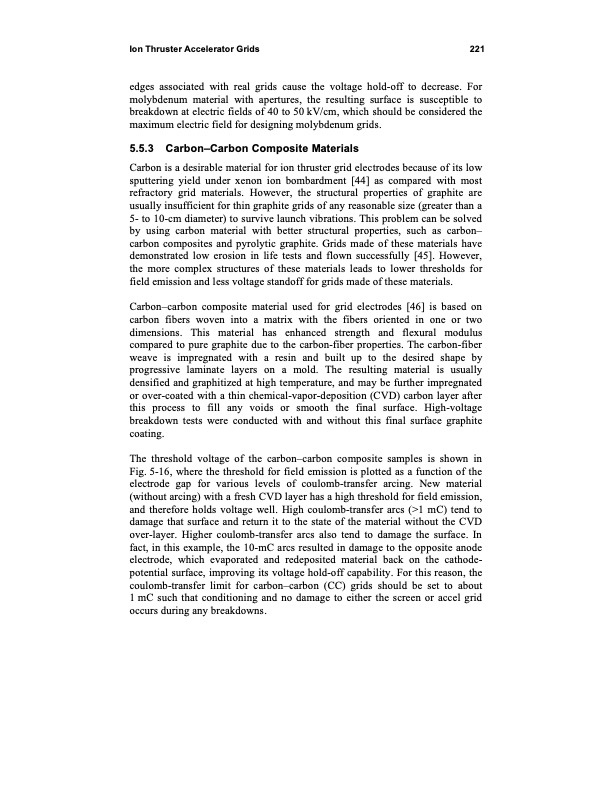
PDF Publication Title:
Text from PDF Page: 233
Ion Thruster Accelerator Grids 221 edges associated with real grids cause the voltage hold-off to decrease. For molybdenum material with apertures, the resulting surface is susceptible to breakdown at electric fields of 40 to 50 kV/cm, which should be considered the maximum electric field for designing molybdenum grids. 5.5.3 Carbon–Carbon Composite Materials Carbon is a desirable material for ion thruster grid electrodes because of its low sputtering yield under xenon ion bombardment [44] as compared with most refractory grid materials. However, the structural properties of graphite are usually insufficient for thin graphite grids of any reasonable size (greater than a 5- to 10-cm diameter) to survive launch vibrations. This problem can be solved by using carbon material with better structural properties, such as carbon– carbon composites and pyrolytic graphite. Grids made of these materials have demonstrated low erosion in life tests and flown successfully [45]. However, the more complex structures of these materials leads to lower thresholds for field emission and less voltage standoff for grids made of these materials. Carbon–carbon composite material used for grid electrodes [46] is based on carbon fibers woven into a matrix with the fibers oriented in one or two dimensions. This material has enhanced strength and flexural modulus compared to pure graphite due to the carbon-fiber properties. The carbon-fiber weave is impregnated with a resin and built up to the desired shape by progressive laminate layers on a mold. The resulting material is usually densified and graphitized at high temperature, and may be further impregnated or over-coated with a thin chemical-vapor-deposition (CVD) carbon layer after this process to fill any voids or smooth the final surface. High-voltage breakdown tests were conducted with and without this final surface graphite coating. The threshold voltage of the carbon–carbon composite samples is shown in Fig. 5-16, where the threshold for field emission is plotted as a function of the electrode gap for various levels of coulomb-transfer arcing. New material (without arcing) with a fresh CVD layer has a high threshold for field emission, and therefore holds voltage well. High coulomb-transfer arcs (>1 mC) tend to damage that surface and return it to the state of the material without the CVD over-layer. Higher coulomb-transfer arcs also tend to damage the surface. In fact, in this example, the 10-mC arcs resulted in damage to the opposite anode electrode, which evaporated and redeposited material back on the cathode- potential surface, improving its voltage hold-off capability. For this reason, the coulomb-transfer limit for carbon–carbon (CC) grids should be set to about 1 mC such that conditioning and no damage to either the screen or accel grid occurs during any breakdowns.PDF Image | Fundamentals of Electric Propulsion: Ion and Hall Thrusters

PDF Search Title:
Fundamentals of Electric Propulsion: Ion and Hall ThrustersOriginal File Name Searched:
Goebel__cmprsd_opt.pdfDIY PDF Search: Google It | Yahoo | Bing
NFT (Non Fungible Token): Buy our tech, design, development or system NFT and become part of our tech NFT network... More Info
IT XR Project Redstone NFT Available for Sale: NFT for high tech turbine design with one part 3D printed counter-rotating energy turbine. Be part of the future with this NFT. Can be bought and sold but only one design NFT exists. Royalties go to the developer (Infinity) to keep enhancing design and applications... More Info
Infinity Turbine IT XR Project Redstone Design: NFT for sale... NFT for high tech turbine design with one part 3D printed counter-rotating energy turbine. Includes all rights to this turbine design, including license for Fluid Handling Block I and II for the turbine assembly and housing. The NFT includes the blueprints (cad/cam), revenue streams, and all future development of the IT XR Project Redstone... More Info
Infinity Turbine ROT Radial Outflow Turbine 24 Design and Worldwide Rights: NFT for sale... NFT for the ROT 24 energy turbine. Be part of the future with this NFT. This design can be bought and sold but only one design NFT exists. You may manufacture the unit, or get the revenues from its sale from Infinity Turbine. Royalties go to the developer (Infinity) to keep enhancing design and applications... More Info
Infinity Supercritical CO2 10 Liter Extractor Design and Worldwide Rights: The Infinity Supercritical 10L CO2 extractor is for botanical oil extraction, which is rich in terpenes and can produce shelf ready full spectrum oil. With over 5 years of development, this industry leader mature extractor machine has been sold since 2015 and is part of many profitable businesses. The process can also be used for electrowinning, e-waste recycling, and lithium battery recycling, gold mining electronic wastes, precious metals. CO2 can also be used in a reverse fuel cell with nafion to make a gas-to-liquids fuel, such as methanol, ethanol and butanol or ethylene. Supercritical CO2 has also been used for treating nafion to make it more effective catalyst. This NFT is for the purchase of worldwide rights which includes the design. More Info
NFT (Non Fungible Token): Buy our tech, design, development or system NFT and become part of our tech NFT network... More Info
Infinity Turbine Products: Special for this month, any plans are $10,000 for complete Cad/Cam blueprints. License is for one build. Try before you buy a production license. May pay by Bitcoin or other Crypto. Products Page... More Info
| CONTACT TEL: 608-238-6001 Email: greg@infinityturbine.com | RSS | AMP |